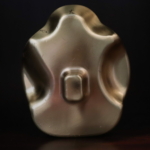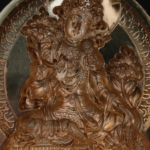Description
This exquisitely crafted Tsatsa mold, made from durable brass, features the elegant figure of Green Tara, the Swift Liberator. Measuring 10 cm tall and 8 cm wide, and weighing 0.65 kg, it showcases intricate details that capture her peaceful smile, one leg poised for action, and the lotus flowers held in her hands. Every fine line of this mold exemplifies sacred artistry, providing a means to produce Tsatsas that emanate her infinite compassion and safeguarding presence.
Green Tara, the emerald-hued mother of compassion, arises from the tears of Avalokiteshvara to swiftly aid all beings in distress. Known as the Saviouress, she embodies active kindness, her right leg poised to step into the world, her left resting in contemplation. With her right hand in the gesture of giving and her left holding the utpala flower of purity, she offers refuge from fear and suffering. Her mantra, Om Tare Tuttare Ture Soha, echoes through the ages, a call to her swift and fearless liberation.
With this mold, the clay you shape becomes a vessel of Green Tara’s blessings, each Tsatsa a beacon of hope and courage. Crafting her form purifies obstacles, invokes protection, and awakens the heart to fearless compassion. Place these Tsatsas on your altar, within a stupa, or in a place of reverence, and their presence will dispel danger and bring solace to all who seek her aid. Whether left in their natural state or touched with color, they stand as embodiments of her swift grace, offering benefit to every being they touch.
How to make Tsatsa
Here is a simple yet profound way to create Tsatsas, explained in five steps with the clarity of a lama’s guidance, for those who seek to walk this sacred path:
Prepare with Intention
Start with a clear mind, dedicating the act to the welfare of all beings. Gather fine, soft clay and a clean mold—perhaps of a Buddha or stupa. Dust the mold lightly with dry clay or ash to ease the release. This prepares the ground for the sacred work.
Shape with Care
Work the clay until smooth and pliable, then press it firmly into the mold. Fill every detail with steady hands, ensuring no gaps remain. This forms the holy image, a reflection of the awakened state.
Release with Patience
Once the clay sets slightly—not too wet or brittle—gently tap or ease the Tsatsa from the mold. Handle it with respect, allowing it to emerge naturally, as truth reveals itself in stillness.
Dry with Reverence
Set the Tsatsa in a shaded, peaceful place to dry—under soft sunlight or near a shrine. Let it harden at its own pace. Some blend sacred ashes or herbs into the clay beforehand, linking it to the blessings of the lineage. This is its time of settling.
Offer with Purpose
When dry, place the Tsatsa on an altar, in a stupa, or at a holy site. Offer a prayer to consecrate it, inviting the presence of enlightenment. It may remain plain or be painted with devotion. Each Tsatsa becomes an offering of merit and purification.
Through these five steps, the ordinary transforms into the extraordinary. Every Tsatsa crafted in this way radiates benefit, illuminating the path for all who encounter it.





















Reviews
There are no reviews yet.